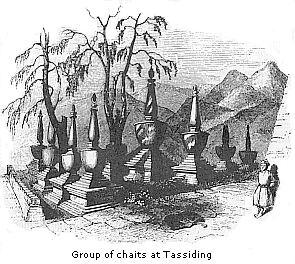
Tassiding, view of and from — Funereal cypress — Camp at Sunnook — Hot vapours — Lama’s house — Temples, decorations, altars, idols, general effect — Chaits — Date of erection — Plundered by Ghorkas — Cross Ratong — Ascend to Pemiongchi — Relation of river-beds to strike of rocks — Slopes of ravines — Pemiongchi, view of — Vegetation — Elevation — Temple, decorations, etc. — Former capital of Sikkim — History of Sikkim — Nightingales — Campbell departs — Tchonpong — Edgeworthia — Cross Rungbee and Ratong — Hoar-frost on plantains — Yoksun — Walnuts — View — Funereal cypresses — Doobdi — Gigantic cypresses — Temples — Snow-fall — Sikkim, etc. — Toys.
Tassiding hill is the steep conical termination of a long spur from a pine-clad shoulder of Kinchinjunga, called Powhungri: it divides the Great Rungeet from its main feeder, the Ratong, which rises from the south face of Kinchin. We crossed the former by a bridge formed of two bamboo stems, slung by canes from two parallel arches of stout branches lashed together.
The ascent for 2,800 feet was up a very steep, dry, zigzag path, amongst mica slate rocks (strike north-east), on which grew many tropical plants, especially the “Tukla,” (Rottlera tinctoria), a plant which yields a brown dye. The top was a flat, curving north-west and south-east, covered with temples, chaits, and mendongs of the most picturesque forms and in elegant groups, and fringed with brushwood, wild plantains, small palms, and apple-trees. Here I saw for the first time the funereal cypress, of which some very old trees spread their weeping limbs and pensile
branchlets over the buildings.* It is not wild in Sikkim, but imported there and into Bhotan from Tibet: it does not thrive well above 6000 feet elevation. It is called “Tchenden ” by the Lepchas, Bhoteeas, and Tibetans, and its fragrant red wood is burnt in the temples.

The Lamas met us on the top of the hill, bringing a noble present of fowls, vegetables and oranges, the latter most acceptable after our long and hot march. The site is admirably chosen, in the very heart of Sikkim, commanding a fine view, and having a considerable river on either side,
* I was not then aware of this tree having been introduced into England by the intrepid Mr. Fortune from China; and as I was unable to procure seeds, which are said not to ripen in Sikkim, it was a great and unexpected pleasure, on my return home, to find it alive and flourishing at Kew.
with the power of retreating behind to the convents of Sunnook and Powhungri, which are higher up on the same spur, and surrounded by forest enough to conceal an army. Considering the turbulent and warlike character of their neighbours, it is not wonderful that the monks should have chosen commanding spots, and good shelter for their indolent lives: for the same reason these monasteries secured views of one another: thus from Tassiding the great temple of Pemiongchi was seen towering 3000 feet over head, whilst to the north-west, up the course of the river, the hill-sides seemed sprinkled with monasteries.
We camped on a saddle near the village of Sunnook, at 4000 feet above the sea; and on the last day of the year we visited this most interesting monastic establishment: ascending from our camp along the ridge by a narrow path, cut here and there into steps, and passing many rocks covered with inscriptions, broken walls of mendongs, and other remains of the via sacra between the village and temple. At one spot we found a fissure emitting hot vapour of the temperature of 65·5°, that of the air being about 50°. It was simply a hole amongst the rocks; and near the Rungeet a similar one is said to occur, whose temperature fluctuates considerably with the season. It is very remarkable that such an isolated spring should exist on the top of a sharp ridge, 2,800 feet above the bottom of this deep valley.
The general arrangement on the summit was, first the Lamas’ houses with small gardens, then three large temples raised on rudely paged platforms, and beyond these, a square walled enclosure facing the south, full of chaits and mendongs, looking like a crowded cemetery, and planted with funereal cypress (Cupressus funebris).
The house of the principal Lama was an oblong square,
the lower story of stone, and the upper of wood: we ascended a ladder to the upper room, which was 24 feet by 8 wattled all round, with prettily latticed windows opening upon a bamboo balcony used for drying grain, under the eaves of the broad thatched roof. The ceiling (of neat bamboo work) was hung with glorious bunches of maize, yellow, red, and brown; an altar and closed wicker cage at one end of the room held the Penates, and a few implements of worship. Chinese carpets were laid on the floor for us, and the cans of Murwa brought round.
The Lama, though one of the red sect, was dressed in a yellow flowered silk robe, but his mitre was red: he gave us much information relative to the introduction of Boodhism into Sikkim.
The three temples stand about fifty yards apart, but are not parallel to one another, although their general direction is east and west.* Each is oblong, and narrowed upwards, with the door at one end; the middle (and smallest) faces the west, the others the east: the doorways are all broad, low and deep, protected by a projecting carved portico. The walls are immensely thick, of well-masoned slaty stones; the outer surface of each slopes upwards and inwards, the inner is perpendicular. The roofs are low and thickly thatched, and project from eight to ten feet all round, to keep off the rain, being sometimes supported by long poles. There is a very low upper story, inhabited by the attendant monks and servants, accessible by a ladder at one end of the building. The main body of the temple is one large apartment, entered through a small transverse vestibule, the breadth of the temple, in which are tall cylindrical
* Timkowski, in his travels through Mongolia (i. p. 193), says, “According to the rules of Tibetan architecture, temples should face the south:” this is certainly not the rule in Sikkim, nor, so far as I could learn, in Tibet either.
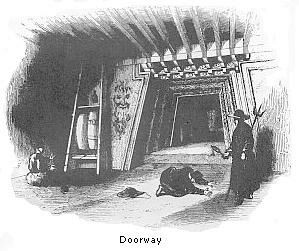
praying-machines. The carving round the doors is very beautiful, and they are gaudily painted and gilded. The northern temple is quite plain: the middle one is simply painted red, and encircled with a row of black heads, with goggle eyes and numerous teeth, on a white ground; it is said to have been originally dedicated to the evil spirits of the Lepcha creed. The southern, which contains the library, is the largest and best, and is of an irregular square shape. The inside walls and floors are plastered with clay, and painted with allegorical representations of Boodh, etc. From the vestibule the principal apartment is entered by broad folding-doors, studded with circular copper bosses, and turning on iron hinges. It is lighted by latticed windows, sometimes protected outside by a bamboo screen. Owing to the great thickness of the walls
(three to four feet), a very feeble light is admitted. In the principal temple, called “Dugang,” six hexagonal wooden columns, narrowed above, with peculiar broad transverse capitals, exquisitely gilded and painted, support the cross-beams of the roof, which are likewise beautifully ornamented. Sometimes a curly-maned gilt lion is placed over a column, and it is always furnished with a black bushy tail: squares, diamonds, dragons, and groups of flowers, vermilion, green, gold, azure, and white, are dispersed with great artistic taste over all the beams; the heavier masses of colour being separated by fine white lines.
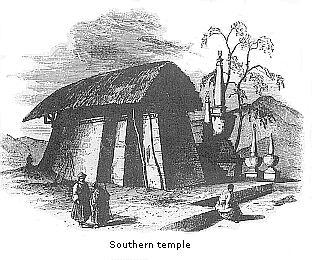
The altars and idols are placed at the opposite end; and two long parallel benches, like cathedral stalls, run down the centre of the building: on these the monks sit at
prayer and contemplation, the head Lama occupying a stall (often of very tasteful design) near the altar.
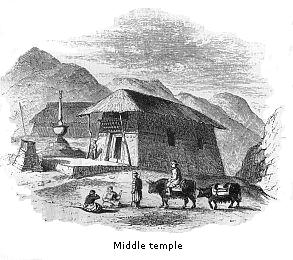
The principal Boodh, or image, is placed behind the altar under a canopy, or behind a silk screen: lesser gods, and gaily dressed and painted effigies of sainted male or female persons are ranged on either side, or placed in niches around the apartment, sometimes with separate altars before them; whilst the walls are more or less covered with paintings of monks in prayer or contemplation. The principal Boodh (Sakya Sing) sits cross-legged, with the left heel up: his left-hand always rests on his thigh, and holds the padmi or lotus and jewel, which is often a mere cup; the right-hand is either raised, with the two forefingers up, or holds the dorje, or rests on the
calf of the upturned leg. Sakya has generally curled hair, Lamas have mitres, females various head-dresses; most wear immense ear-rings, and some rosaries. All are placed on rude pediments, so painted as to convey the idea of their rising out of the petals of the pink, purple, or white lotus. None are in any way disagreeable; on the contrary most have a calm and pleasing expression, suggestive of contemplation.
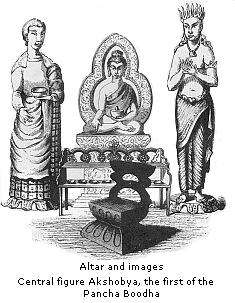
The great or south temple contained a side altar of very elegant shape, placed before an image encircled by a glory. Flowers, juniper, peacock’s feathers, pastiles, and rows of brass cups of water were the chief ornaments of the altars,
besides the instruments I have elsewhere enumerated. In this temple was the library, containing several hundred books, in pigeon-holes, placed in recesses.*
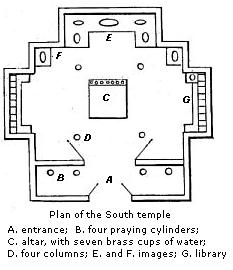
The effect on entering these cold and gloomy temples is very impressive; the Dugang in particular is exquisitely ornamented and painted, and the vista from the vestibule to the principal idol, of carved and coloured pillars and beams, is very picturesque. Within, the general arrangement of the colours and gilding is felt to be harmonious and pleasing, especially from the introduction of slender white streaks between the contrasting masses of colour,
* For a particular account of the images and decorations of these temples, sea Dr. Campbell’s paper in “Bengal Asiatic Society’s Trans.,” May, 1849. The principal object of veneration amongst the Ningma or red sect of Boodhists in Sikkim and Bhotan is Gorucknath, who is always represented sitting cross-legged, holding the dorje in one hand, which is raised; whilst the left rests in the lap and holds a cup with a jewel in it. The left arm supports a trident, whose staff pierces three sculls (a symbol of Shiva), a rosary hangs round his neck, and he wears a red mitre with a lunar crescent and sun in front.
as adopted in the Great Exhibition building of 1851. It is also well worthy of remark that the brightest colours are often used in broad masses, and when so, are always arranged chromatically, in the sequence of the rainbow’s hues, and are hence never displeasing to the eye. The hues, though bright, are subdued by the imperfect light: the countenances of the images are all calm, and their expression solemn. Whichever way you turn, the eye is met by some beautiful specimen of colouring or carving, or some object of veneration. The effect is much heightened by the incense of juniper and sweet-smelling herbs which the priests burn on entering, by their grave and decorous conduct, and by the feeling of respect that is demanded by a religion which theoretically inculcates and adores virtue in the abstract, and those only amongst men who practise virtue. To the idol itself the Boodhist attaches no real importance; it is an object of reverence, not of worship, and no virtue or attribute belong to it per se; it is a symbol of the creed, and the adoration is paid to the holy man whom it represents.
Beyond the temples are the chaits and mendongs, scattered without much order; and I counted nearly twenty-five cbaits of the same form,* between eight and thirty feet high. The largest is consecrated to the memory of the Rajah’s eldest son, who, however, is not buried here. A group of these structures is, as I have often remarked, extremely picturesque, and those at Tassiding, from their
* In Sikkim the form of the cube alone is always strictly preserved; that of the pyramid and hemisphere being often much modified. The cube stands on a flight of usually three steps, and is surmounted by a low pyramid of five steps; on this is placed a swelling, urn-shaped body, which represents the hemisphere, and is surmounted by another cube. On the latter is a slender, round or angled spire (represented by a pyramid in Burma), crowned with a crescent and disc, or sun, in moon. Generally, the whole is of stone, with the exception of the spire, which is of wood, painted red.
number, variety, and size, their commanding and romantic position, and their being interspersed with weeping cypresses, are particularly so.
The Tassiding temples and convents were founded upwards of 300 years ago, by the Lamas who accompanied the first Rajah to Sikkim; and they have been continuously served by Lamas of great sanctity, many of whom have been educated at Lhassa. They were formerly very wealthy, but during the Nepal war they were plundered of all their treasures, their silver gongs and bells, their best idols, dorjes, and manis, and stripped of their ornaments; since which time Pemiongchi has been more popular. In proof of their antiquity, it was pointed out that most of the symbols and decorations were those of pure Lama Boodhism, as practised in Tibet.
Although the elevation is but 4,840 feet, the weather was cold and raw, with rain at noon, followed by thunder and lightning. These electrical disturbances are frequent about midsummer and midwinter, prevailing over many parts of India.
January 1st, 1849.—The morning of the new year was bright and beautiful, though much snow had fallen on the mountains; and we left Sunnook for Pemiongchi, situated on the summit of a lofty spur on the opposite side of the Ratong. We descended very steeply to the bed of the river (alt. 2,480 feet) which joins the Great Rungeet below the convents. The rocks were micaceous, dipping west and north-west 45°, and striking north and north-east, which direction prevailed for 1000 feet or so up the opposite spur. I had observed the same dip and stroke on the east flank of the Tassiding spur; but both the Ratong on its west side, and the Great Rungeet on the east, flow in channels that show no relation to either the dip or strike.
I have generally remarked in Sikkim that the channels of the rivers when cutting through or flowing at the base of bluff cliffs, are neither parallel to nor at right angles to the strike of the rocks forming the cliffs. I do not hence conclude that there is no original connection between the directions of the rivers, and the lines of fracture; but whatever may have once subsisted between the direction of the fissures and that of the strike, it is in the Sikkim Himalaya now wholly masked by shiftings, which accompanied subsequent elevations and depressions.
Mr. Hopkins has mathematically demonstrated that the continued exertion of a force in raising superimposed strata would tend to produce two classes of fractures in those strata; those of the first order at right angles to the direction of the wave or ridge (or line of strike); those of the second order parallel to the strike. Supposing the force to be withdrawn after the formation of the two fractures, the result would be a ridge, or mountain chain, with diverging fissures from the summit, crossed by concentric fissures; and the courses which the rivers would take in flowing down the ridge, would successively be at right angles and parallel to the strike of the strata. Now, in the Himalaya, a prevalent strike to the north-west has been recognised in all parts of the chain, but it is everywhere interfered with by mountains presenting every other direction of strike, and by their dip never remaining constant either in amount or direction. Consequently, as might be expected, the directions of the river channels bear no apparent relation to the general strike of the rocks.
We crossed the Ratong (twenty yards broad) by a cane bridge, suspended between two rocks of green chlorite, full of veins of granite. Ascending, we passed the village of Kameti on a spur, on the face of which
were strewed some enormous detached blocks of white and pink stratified quartz: the rocks in situ were all chlorite schist.
Looking across the valley to the flank of Mainom, the disposition of the ridges and ravines on its sides was very evident; many of the latter, throughout their westerly course, from their commencement at 10,000 feet, to their debouchure in the Great Rungeet at 2000, had a bluff, cliffy, northern flank, and a sloping southern one. The dip of the surfaces is, therefore, north-west, the exposure consequently of the villages which occupy terraces on the south flanks of the lateral valleys. The Tassiding spur presented exactly the same arrangement of its ravines, and the dip of the rocks being north-west, it follows that the planes of the sloping surfaces coincide in direction (though not in amount of inclination) with that of the dip of the subjacent strata, which is anything but a usual phenomenon in Sikkim.
The ascent to Pemiongchi continued very steep, through woods of oaks, chesnuts, and magnolias, but no tree-fern, palms, Pothos, or plantain, which abound at this elevation on the moister outer ranges of Sikkim. The temple (elev. 7,083 feet) is large, eighty feet long, and in excellent order, built upon the lofty terminal point of the great east and west spur that divides the Kulhait from the Ratong and Rungbee rivers; and the great Changachelling temple and monastery stand on another eminence of the same ridge, two miles further west.
The view of the snowy range from this temple is one of the finest in Sikkim; the eye surveying at one glance the vegetation of the Tropics and the Poles. Deep in the valleys the river-beds are but 3000 feet above the sea, and are choked with fig-trees, plantains, and palms; to
these succeed laurels and magnolias, and higher up still, oaks, chesnuts, birches, etc.; there is, however, no marked line between the limits of these two last forests, which form the prevailing arboreous vegetation between 4000 and 10,000 feet, and give a lurid line to the mountains. Pine forests succeed for 2000 feet higher, when they give place to a skirting of rhododendron and berberry. Among these appear black naked rocks, rising up in cliffs, between which are gulleys, down which the snow now (on the 1st January) descended to 12,000 feet. The mountain flanks are much more steep and rocky than those at similar heights on the outer ranges, and cataracts are very numerous, and of considerable height, though small in volume.
Pemiongchi is at the same elevation as Dorjiling, and the contrast between the shoulders of 8000 to 10,000 feet on Kinchinjunga, and those of equal height on Tendong and Tonglo, is very remarkable: looking at the latter mountains from Dorjiling, the observer sees no rock, waterfall, or pine, throughout their whole height; whereas the equally wooded flanks of these inner ranges are rocky, streaked with thread-like waterfalls, and bristling with silver firs.
This temple, the most ancient in Sikkim, is said to be 400 years old; it stands on a paved platform, and is of the same form and general character as those of Tassiding. Inside, it is most beautifully decorated, especially the beams, columns, capitals and architraves, but the designs are coarser than those of Tassiding.* The square end of every beam in the roof is ornamented either with a lotus flower or with a Tibetan character, in endless diversity
* Mr. Hodgson informed me that many of the figures and emblems in this temple are those of Tantrica Boodhism, including Shiva, Devi, and other deities usually called Brahminical; Kakotak, or the snake king, a figure terminating below in a snake, is also seen; with the tiger, elephant, and curly-maned lion.
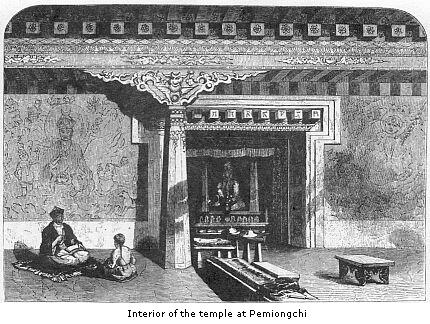
of colour and form, and the walls are completely covered with allegorical paintings of Lamas and saints expounding or in contemplation, with glories round their heads, mitred, and holding the dole and jewel.
The principal image is a large and hideous figure of Sakya-thoba, in a recess under a blue silk canopy, contrasting with a calm figure of the late Rajah, wearing a cap and coronet.
Pemiongchi was once the capital of Sikkim, and called the Sikkim Durbar: the Rajah’s residence was on a curious flat to the south of the temple, and a few hundred feet below it, where are the remains of (for this country) extensive walls and buildings. During the Nepal war, the Rajah was driven west across the Teesta, whilst the Ghorkas plundered Tassiding, Pemiongchi, Changachelling, and all the temples and convents to the east of that river. It was then that the famous history of Sikkim,* compiled by the Lamas of Pemiongchi, and kept at this temple, was destroyed, with the exception of a few sheets, with one of which Dr. Campbell and myself were each presented. We were told that the monks of Changachelling and those of this establishment had copied what remained, and were busy compiling from oral information, etc.: whatever value the original may have possessed, however, is irretrievably lost. A magnificent copy of the Boodhist Scriptures was destroyed at the same time; it consisted of 400 volumes, each containing several hundred sheets of Daphne paper.
The ground about the temple was snowed; and we descended a few hundred feet, to encamp in a most picturesque grove, among chaits and inscribed stones, with
* This remarkable and beautiful manuscript was written on thick oblong sheets of Tibet paper, painted black to resist decay, and the letters were yellow and gold. The Nepalese soldiers wantonly employed the sheets to roof the sheds they erected, as a protection from the weather.
a peep of the temples above. Nightingales warbled deliciously night and morning, which rather surprised us, as the minimum thermometer fell to 27·8°, and the ground next day was covered with hoar-frost; the elevation being 6,580 feet. These birds migrate hither in October and November, lingering in the Himalayan valleys till the cold of early spring drives them further south, to the plains of India, whence they return north in March and April.
On the 2nd of January I parted from my friend, who was obliged to hurry to the great annual fair at Titalya. I regretted much being unable to accompany Dr. Campbell to this scene of his disinterested labours, especially as the Nawab of Moorshedabad was to be present, one of the few wealthy native princes of Bengal who still keep a court worth seeing; but I was more anxious to continue my explorations northward till the latest moment: I however accompanied him for a short distance on his way towards Dorjiling. We passed the old Durbar, called Phieungoong (“Bamboo-hill,” so named from the abundance of a small bamboo, “Phieung.”) The buildings, now in ruins, occupy a little marshy flat, hemmed in by slate rocks, and covered with brambles and Andromeda bushes. A wall, a bastion, and an arched gateway, are the only traces of fortifications; they are clothed with mosses, lichens, and ferns.
A steep zigzag path, descending amongst long grass and scarlet rhododendrons, leads to the Kaysing Mendong.* Here I bade adieu to Dr. Campbell, and toiled up the hill, feeling very lonely. The zest with which he had entered into all my pursuits, and the aid he had afforded me, together with the charm that always attends companionship with one who enjoys every incident of travel, had so attracted me to him that I found it difficult to recover my spirits.
* Described at page 287.
It is quite impossible for anyone who cannot from experience realise the solitary wandering life I had been leading for months, to appreciate the desolate feeling that follows the parting from one who has heightened every enjoyment, and taken far more than his share of every annoyance and discomfort: the few days we had spent together appeared then, and still, as months.
On my return to Pemiongchi I spent the remainder of the day sketching in the great temple, gossiping with the Lamas, and drinking salted and buttered tea-soup, which I had begun to like, when the butter was not rancid.
My route hence was to be along the south flank of Kinchinjunga, north to Jongri, which lay about four or five marches off, on the road to the long deserted pass of Kanglanamo, by which I had intended entering Sikkim from Nepal, when I found the route up the Yalloong valley impracticable. The village and ruined convents of Yoksun lay near the route, and the temples of Doobdi, Catsuperri and Molli, on the Ratong river.
I descended to the village of Tchonpong (alt. 4,980 feet), where I was detained a day to obtain rice, of which I required ten days’ supply for twenty-five people. On the way I passed groves of the paper-yielding Edgeworthia Gardneri: it bears round heads of fragrant, beautiful, yellow flowers, and would be a valuable acquisition to an English conservatory.
From Tchonpong we descended to the bed of the Rungbee (alt. 3,160 feet), an affluent of the Ratong, flowing in a deep galley with precipitous sides of mica schist full of garnets, dipping west and north-west 45°: it was spanned by a bridge of two loose bamboo culms, about fifteen yards long, laid across without handrails; after wet sand had been thrown on it the bare-footed coolies crossed
easily enough, but I, having shoes on, required a hand to steady me. From this point we crossed a lofty spur to the Ratong (alt. 3000 feet), where we encamped, the coolies being unable to proceed further on such very bad roads. This river descends from the snows of Kinchin, and consequently retains the low temperature 42°, being fully 7° colder than the Rungbee, which at an elevation of but 3000 feet appears very remarkable: it must however be observed that scarcely anywhere does the sun penetrate to the bottom of its valley.
We encamped on a gravelly flat, fifty feet above the river, strewn with water-worn boulders, and so densely covered with tall Artemisiæ, gigantic grasses, bamboo, plantain, fern, and acacia, that we had to clear a space in the jungle, which exhaled a rank heavy smell.
Hoar-frost formed copiously in the night, and though above the sun’s rays were very powerful, they did not reach this spot till 7.30 a.m., the frost remaining in the shade till nearly 9 a.m.; and this on plantains, and other inhabitants of hot-houses in England.
Hence I ascended to Yoksun, one of the most curious and picturesque spots in Sikkim, and the last inhabited place towards Kinchinjunga. The path was excessively steep and rocky for the first mile or two, and then alternately steep and flat. Mixed with many tropical trees, were walnuts of the common English variety; a tree, which, though planted here, is wild near Dorjiling, where it bears a full-sized fruit, as hard as a hickory-nut: those I gathered in this place were similar, whereas in Bhotan the cultivated nut is larger, thin-shelled, and the kernel is easily removed. We ascended one slope, of an angle of 36° 30′, which was covered with light black mould, and had been recently cleared by fire: we found millet
now cultivated on it. From the top the view of the Ratong valley was very fine: to the north lay Yoksun, appearing from this height to occupy a flat, two miles long and one broad, girdled by steep mountains to the north and east, dipping very suddenly 2,200 feet to the Ratong on the west. To the right was a lofty hill, crowned with the large temple and convents of Doobdi, shadowed by beautiful weeping cypresses, and backed by lofty pine-clad mountains. Northward, the gorge of the Ratong opened as a gloomy defile, above which rose partially snowed mountains, which shut out Kinchinjunga. To the west, massive pine-clad mountains rose steeply; while the little hamlet of Lathiang occupied a remarkable shelf overhanging the river, appearing inaccessible except by ropes from above. South-west, the long spurs of Molli and Catsuperri, each crowned with convents or temples, descended from Singalelah; and parallel to them on the south; but much longer and more lofty, was the great mountain range north of the Kulbait, with the temples and convents of Pemiongchi, and Changachelling, towering in the air. The latter range dips suddenly to the Great Rungeet, where Tassiding, with its chaits and cypresses, closed the view. The day was half cloud, half sunshine; and the various effects of light and shade, now bringing out one or other of the villages and temples, now casting the deep valleys into darker gloom, was wonderfully fine.
Yoksun was the earliest civilised corner of Sikkim, and derived its name (which signifies in Lepcha “three chiefs”) from having been the residence of three Lamas of great influence, who were the means of introducing the first Tibetan sovereign into the country. At present it boasts of but little cultivation, and a scattered population, inhabiting a few hamlets, 5,500 feet above the sea: beautiful lanes
and paths wind everywhere over the gentle slopes, and through the copsewood that has replaced the timber-trees of a former period. Mendongs and chaits are very numerous, some of great size; and there are also the ruins of two very large temples, near which are some magnificent weeping cypresses, eighty feet high. These fine trees are landmarks from all parts of the flat; they form irregular cones of pale bright green, with naked gnarled tops, the branches weep gracefully, but not like the picture in Macartney’s Embassy to China, whence originated the famous willow-pattern of our crockery. The ultimate branchlets are very slender and pendulous; my Lepcha boys used to make elegant chaplets of them, binding the withes with scarlet worsted. The trunk is quite erect, smooth, cylindrical, and pine-like; it harbours no moss, but air-plants, Orchids, and ferns, nestle on the limbs, and pendulous lichens, like our beard-moss, wave from the branches.
In the evening I ascended to Doobdi. The path was broad, and skilfully conducted up a very steep slope covered with forest: the top, which is 6,470 feet above the sea, and nearly 1000 above Yoksun, is a broad partially paved platform, on which stand two temples, surrounded by beautiful cypresses: one of these trees (perhaps the oldest in Sikkim) measured sixteen and a half feet in girth, at five feet from the ground, and was apparently ninety feet high: it was not pyramidal, the top branches being dead and broken, and the lower limbs spreading; they were loaded with masses of white-flowered Cœlogynes, and Vacciniums. The younger trees were pyramidal.
I was received by a monk of low degree, who made many apologies for the absence of his superior, who had
been ordered an eight years’ penance and seclusion from the world, of which only three had passed. On inquiry, I learnt the reason for this; the holy father having found himself surrounded by a family, to which there would have been no objection, had he previously obtained a dispensation. As, however, he had omitted this preliminary, and was able to atone by prayer and payment, he had been condemned to do penance; probably at his own suggestion, as the seclusion will give him sanctity, and eventually lead to his promotion, when his error shall have been forgotten.
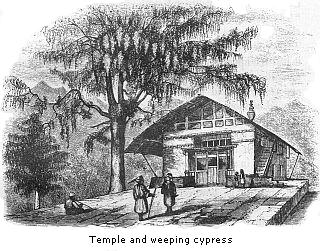
Both temples are remarkable for their heavily ornamented, two-storied porticos, which occupy nearly the whole of one end. The interior decorations are in a ruinous
condition, and evidently very old; they have no Hindoo emblems.
The head Lama sent me a present of dried peaches, with a bag of walnuts, called “Koal-kun” by the Lepchas, and “Taga-sching” by the Bhoteeas; the two terminations alike signifying “tree.”
The view of Yoksun from this height was very singular: it had the appearance of an enormous deposit banked up against a spur to the south, and mountains to the east, and apparently levelled by the action of water: this deposit seemed as though, having once completely filled the valley of the Ratong, that river had cut a gorge 2000 feet deep between it and the opposite mountain.
Although the elevation is so low, snow falls abundantly at Doobdi in winter; I was assured that it has been known of the depth of five feet, a statement I consider doubtful; the quantity is, however, certainly greater than at equal heights about Dorjiling, no doubt owing to its proximity to Kinchinjunga.
I was amused here by watching a child playing with a popgun, made of bamboo, similar to that of quill, with which most English children are familiar, which propels pellets by means of a spring-trigger made of the upper part of the quill. It is easy to conclude such resemblances between the familiar toys of different countries to be accidental, but I question their being really so. On the plains of India, men may often be seen for hours together, flying what with us are children’s kites; and I procured a jews’-harp from Tibet. These are not the toys of savages, but the amusements of people more than half-civilised, and with whom we have had indirect communication from the earliest ages. The Lepchas play at quoits, using slate for the purpose, and at the Highland
games of “putting the stone” and “drawing the stone.” Chess, dice, draughts, Punch, hockey, and battledore and shuttlecock, are all Indo-Chinese or Tartarian; and no one familiar with the wonderful instances of similarity between the monasteries, ritual, ceremonies, attributes, vestments, and other paraphernalia of the eastern and western churches, can fail to acknowledge the importance of recording even the most trifling analogies or similarities between the manners and customs of the young as well as of the old.